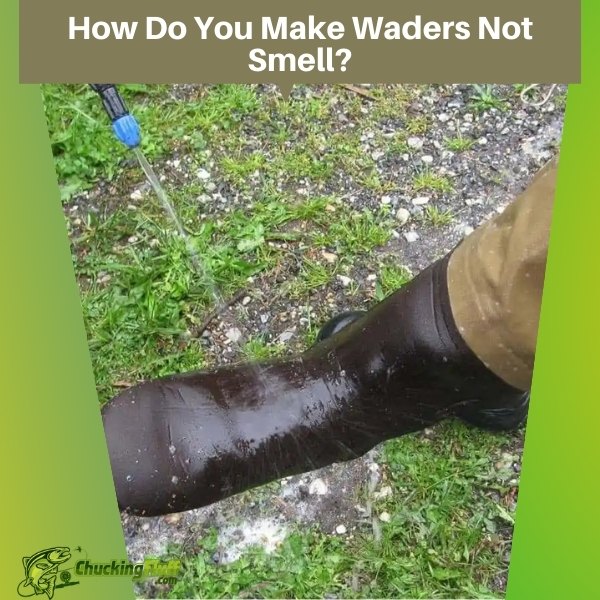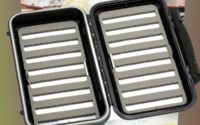| Disclosure: Just to be open and honest the buttons and links you click on in the website will in most cases take you to another website where you can purchase the products I am reviewing. As an Amazon Associate I earn from qualifying purchases. |
How Do You Make Waders Not Smell? Effective Tips and Tricks

Stinky waders are among the biggest problems fly fishers have been suffering from for ages.
What makes it even more difficult to solve is the type of gear material and how it has been made.
Unlike our regular cotton, jean, and polyester daily wear that you can deodorize with common baking soda and other approaches, waders need you to be smart to ensure they are smelling fresh unless from the day’s sweat.
So, how do you make waders not smell?
The only solution to making waders smell-free is proper maintenance.
Here, I mean from the day of purchase onwards because a slack in between will render your gear embarrassing before you and anyone near you.
Cleaning is the biggest part of wader maintenance and doing it right removes dirt, bacteria, and any order thus prolonging their life.
Proper drying sums up the process to ensure there isn’t any moisture that can breed bacteria that cause foul smell and infections when you wear your waders again.
Quick Post Navigation
How Do You Make Waders Not Smell?
First, where does the smell of waders come from?
The stench from waders comes from bacteria and this affects even the highest grade of breathable waders the world has seen.
And FYI, such bacteria love warm, moist areas of the waders, and besides the malodorous smell, these can cause awful infections.
It gets worse if bacteria-filled waders get in contact with open wounds on your body.
Staph infection is the most typical wader-borne infection which can be fatal.
Let’s see how you can make your waders free from these bacteria that cause bad smell.
Thorough Cleaning
Fly fishing days can overstretch your schedule, leave you drained and fatigued or you might return home and get onto other life’s duties forgetting how crucial it is to deal with dirty waters as soon as possible.
Even if fishing from a boat, your waders will still be in contact with water from vessel splashes, dust from wind gusts, and dirt from the atmosphere you can’t see.
It is advisable to wash your waders after each use to remove dirt and bacteria-causing germs.
Staphylococcus is among the stubborn ones that need more cleaning.
Use a mild detergent and clean cold water to thoroughly clean your waders and if you want to get extra, go in with a soft brush for the crotch, ankle, waist, and Stockingfoot areas.
While at it, AVOID USING BLEACH ON YOUR WADERS as its contents can be harsh on the fabric.
Once you are done cleaning, proper rinsing under clean water should help flush out all the dirt, soap, bacteria, and gunk.
Rinse your waders thrice or more times before using a mild disinfectant on the fabric.
Keen Disinfection
We’ve ruled out bleach as a cleaning agent for waders so don’t count it here.
Disinfecting your gear helps to kill most bacteria and invasive species and besides protecting you from discomfort and infections, it makes your gear safe for use in the next environment you’ll be fishing.
5% dish detergent solutions like Palmolive and Dawn are good starters or common table salt in the same percentage works well.
For salt disinfection, ensure it is on waders with no metallic items because corrosion is quick in saline environments.
Anglers are very experimental and, surprisingly, most of their hacks work effectively.
Did you know that stacking your waders in the freezer until hard disinfects them?
However, you need to do this after thoroughly cleaning and rinsing your gear.
The extremely low temperatures kill any bacteria in the waders and once dry, they’ll not smell.
Drying
Sun drying your waders is the surest bet of getting rid of all the moisture in them.
You have to keep changing the sides to ensure the inside and outside are bone dry, paying attention to the seams, pockets, and zipper areas.
In winter other alternatives like furnace rooms, blow dryers, and wader dryers come in handy for this.
However, you have to be cautious because too much heat ruins this gear because of the material.
Your heat source should be distant to dry the waders but not damage them.
Once dry, store them in a dry area free from dirt or moisture.
How Do You Make Waders Not Smell? – FAQs
See some common questions on waders and stench and how you can prevent this or sort it out.
Q) Can I use Wader Detergent to Clean Waders?
A) Yes, as long as it is safe on your material, and removes all the dirt without stripping the gear’s protective coating, use it.
Loon Outdoors, Gear Aid, and other wader manufacturers have cleaning products you can use.
But if these are out of reach, mild dishwashing soap does the job effectively.
Q) How Do I Prevent Bad Smell in Stocking Feet?
A) Woolen socks work well in the feet area if you’ll be in your waders for long.
Ensure your feet aren’t too warm and sweaty otherwise the moisture is a good environment for bacteria that cause bad odor to thrive.
Dry your stocking feet completely while turning them inside out in between the drying session to be sure that there is no moisture left.
Q) Do Wading Jackets Smell?
A) If not properly cleaned, disinfected, and dried, wading jackets, fishing vests, packs, and any wading gear or apparel can smell.
Conclusion
How do you make waders not smell?
Proper cleaning, disinfecting, and drying are the secrets to smell-free waders.
You want to maintain your gear in the best way possible to prevent bacteria that cause foul smell from breeding in them and posing a higher risk of contracting Staph infections if you have open wounds.
Cleaning your waders is simple and shouldn’t be costly.
You only need clean water and mild dishwashing soap.
Some salt will come in handy as a second disinfectant but ensure you rinse your waders again with fresh water to prevent corrosion on metallic parts or the saline from stripping the wader coating.
If salt isn’t an option for you, get them into your freezer for a day or two before drying the waders completely.


